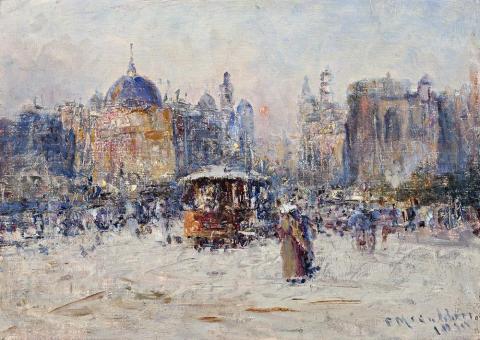PRINCES BRIDGE, 1910
FREDERICK McCUBBIN
oil on canvas board
25.0 x 35.0 cm
signed and dated lower left: F McCubbin / 1910
W. R. Sedon, Melbourne (label attached verso, as 'Swanston St from Princes Bridge', 1910)
Private collection, Melbourne
Deutscher Fine Art, Melbourne
Trevor Bussell, Sydney (label attached verso)
Sotheby's, Melbourne, 19 August 1996, lot 140
Private collection, Melbourne
Deutscher and Hackett, Sydney, 28 August 2013, lot 43
Roger Langsworth, Sydney
Frederick McCubbin exhibition to mark the centenary of the artist's birth in 1855, National Gallery of Victoria, Melbourne, 4 November – 31 December 1955, cat. 34 (label attached verso, lent by W.R. Sedon Esq.)
Australian Colonial and Impressionist Paintings, Deutscher Fine Art, Melbourne, 22 March – 9 April 1982, cat. 31 (illus. in exhibition catalogue)
McCubbin: Last Impressions 1907–1917, National Gallery of Australia, Canberra, 14 August – 1 November 2009; Art Gallery of Western Australia, Perth, 12 December 2009 – 28 March 2010; Bendigo Art Gallery, Victoria, 24 April – 25 July 2010 (label attached verso)
Gray, A., McCubbin: Last Impressions 1907–1917, National Gallery of Australia, Canberra, 2009, cat. 30, p. 99 (illus. and frontispiece)
Frederick McCubbin sketchbooks, National Gallery of Victoria, Melbourne
Frederick McCubbin excelled in portraying the poetic in nature. A master of early morning mists, rippling sunlight and the shades of twilight, he captured these transient moments in the sylvan glades of Macedon and along the winding banks of Melbourne’s Yarra River. The city of Melbourne also exercised a special appeal throughout his very productive life. Princes Bridge spanning the Yarra River was a favourite spot. The visually splendid Princes Bridge, c.1908 in the collection of the National Gallery of Victoria, Melbourne (lately redubbed ‘Arrival of the Duke and Duchess of York, Melbourne 1901’) is one of the finest. Sketched in 1901 when the city was decorated in celebratory splendour for the royal visit on the occasion of the opening of the first Commonwealth Parliament, McCubbin later translated the oil sketch into the larger painting, a Turneresque gem of light and colour. Between times, Princes Bridge featured in two other related paintings, Swanston Street, 1906 and Princes Bridge, 1906.1 The first presents a view of the bridge from the south east side. The second is from the left hand side of the bridge, both showing the old Flinders Street railway clock tower and St Paul’s Cathedral before the gothic spires were added. For our painting, Princes Bridge, 1910, McCubbin moved to the right hand side of the bridge, looking up Swanston Street and filling the busy scene as before with people, horses and carts, and a cable tram. The clock tower has gone and added, the newly completed classical dome of Flinders Street Railway Station.
While Princes Bridge with its changing Melbourne skyline can claim historical interest, the location is the occasion, not the subject. Translated through the impressionistic style of McCubbin’s later years and the glorious colour schemes influenced by J. M. W. Turner, McCubbin created a celebration of sheer visual delight. The activity of the scene, captured in vivid strokes of the palette knife, harmonises with the poetry of the moment in the atmospheric play of colour and light as the late afternoon touches twilight. Worked on the spot en plein air, McCubbin used an artist’s board, intimate in scale and suited to the quick sketch. As such, it is a veritable gem of sparkling paint, vivacious and richly textured.
Princes Bridge and Flinders Street Railway Station had a particular appeal for McCubbin, who, about this time, painted a number of same-sized views of the station under construction or in the early morning light as forms dissolved in colour and atmosphere. Later, he turned his site to Collins Street, painting from the back seat of the family’s car, an old Renault. Three glorious paintings of the same title Collins Street, c.1915 are in the collections of the National Gallery of Victoria, Melbourne, Art Gallery of Western Australia, Perth and the Geelong Art Gallery, Victoria. Princes Bridge and these allied oils provide us with a luxuriance of painterly brilliance and atmospheric effects. They are truly gems of art.
1. For Swanston Street, 1906: see James MacDonald, The Art of Frederick McCubbin, Lothian Book Publishing, Melbourne, 1916, plate xviii. Princes Bridge, 1906, oil on sketching tablet, 25 x 35cm, once The Melbourne Herald collection, Melbourne.
DAVID THOMAS
